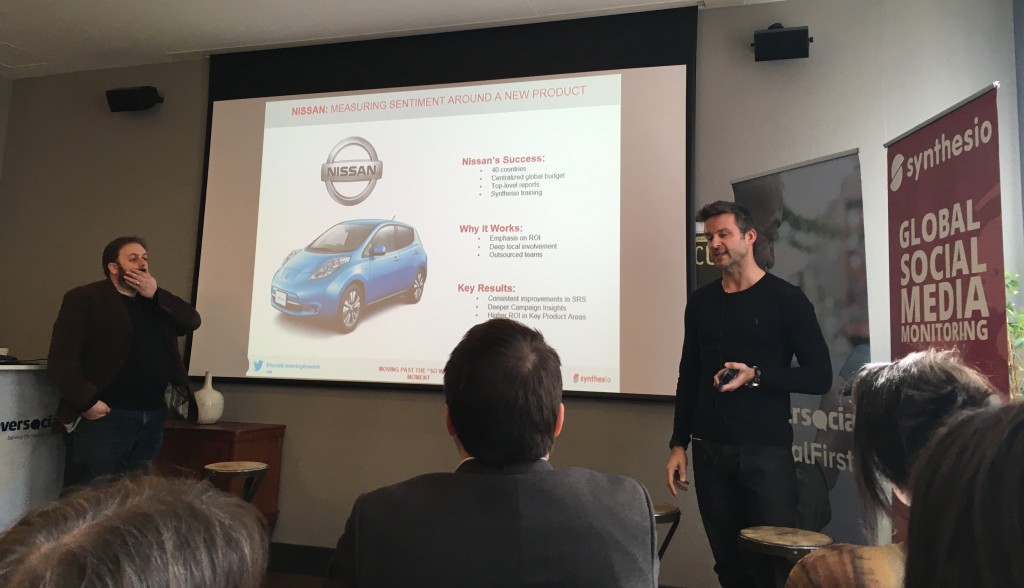Using social listening to make business decisions: two great case studies
A week ago I attended a Social Listening Roadshow in London, put on by Conversocial and Synthesio, which featured some interesting insights and two case studies – from car company, Nissan, and airline, Aer Lingus. Here’s the low-down…
Firstly, for those that don’t know – Conversocial is a social customer service tool and Synthesio is a social intelligence tool used for social listening. They’ve partnered up to share best practice.
Chief Strategy Officer at Synthesio, Matt Zito kicked off the roadshow on the topic of social media data. Anyone working in digital marketing today is bombarded with data, but what are we doing with it? This is what Matt called the ‘so what moment.’ We need to use the insights we get from social media and make it strategic to our business.
If you aren’t convinced of the benefits of social listening, here are a few facts that illustrate the impact social has on the consumer buying decision.
- 93% of marketers use social media for business
- 50% of consumers are more likely to buy a product from a company that they can contact via social media
- 31% of consumers say their decision to buy a product was influences by something they read in a blog
- 56% of consumers who actively use social media to interact with businesses feel a stronger connection to those businesses
These obviously suggest social has a big impact on the buying decision and that social media can be a hub for conversation.
Do you listen to what your consumers are saying?
With this in mind, first up, you need to figure out where people are talking about your brand. It might be where you least expect it, so don’t just check Facebook and Twitter; it could be in blogs or forums too. Using a tool like Synthesio enables you to find out what people are saying about your brand across all channels. More important than just collecting this data is turning it into real, valuable insights that are relevant to the wider business. The message of this session was: don’t just keep the insights within the social team, tie them back to real business.
Head of Digital for Africa, Middle East and India at Nissan, David Parkinson, then gave an example of when Nissan launched the Datsun in India. Nissan used tools to listen to what people were saying about the car. Nissan found that people liked the size of the boot but didn’t like the interior. They couldn’t change anything on the car, but they knew it was useful information. Nissan took these insights to the marketing team and started to market the boot size – in other words, they used their social insights to power a business decision.
Head of Social Media at Aer Lingus, Paul Buckley gave an example when the airline removed their chicken and stuffing sandwich from their in-flight menu. People were instantly complaining about it on social media (I personally am a big fan of a chicken and stuffing sandwich so I would be tweeting my sorrows too).
After a few days they were still complaining about it. As a result, Aer Lingus spoke to the production team about bringing it back. Aer Lingus reached out to their customers via social to announce that it was back. Announcing the return of the sandwich via social allowed them to publicly resolve the issue – which is another nice opportunity that social media offers.
Professional Services Director at Conversocial, Chris Venus, then spoke about the importance of customer care on social media, i.e. how moving social data out of the social media team can also impact on your social customer service.
Apparently, 80% of UK consumer conversations with brands currently happen on Twitter and not talking to consumers on social media can lead to a 15% increase in your churn rate. In short, you expect a response to your social content and ads and customers expect you to reply to them too.
Chris gave five helpful tips on implementing social customer service:
- Select an experienced team with in-depth knowledge of your brand/business to respond on all social channels
- Respond to consumers in a timely fashion
- Report the success of social responses and resolution of a query
- Have department buy-in. How does your social customer service approach resonate with your other colleagues/departments?
- Be aware that the consumer can choose when they interact with a brand, so they are in charge.
It was a really insightful day and, while here at OST Marketing we have a pretty strong handle on social media monitoring tools and processes, I took away lots of pearls of wisdom. Big thanks to Conversocial, Synthesio, Paul from Aer Lingus and David from Nissan for an insightful afternoon.



